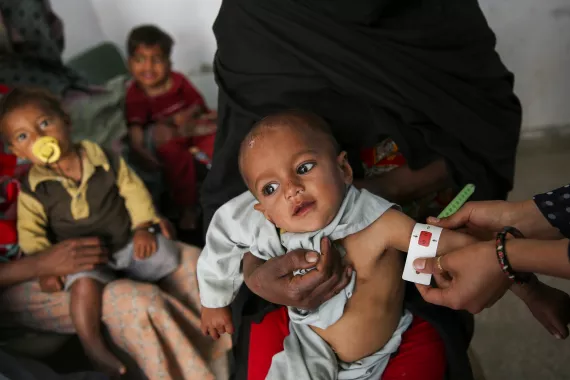
It is not only a wavering economy which is ballooning into a major socio-economic factor behind civilian discontent in Pakistan. Malnourishment of its population is also driving the upsurge of diseases in the struggling South Asian nation facing multiple challenges.
A healthy nation can fight back its internal turmoil but the scourge of malnourishment is slowly overburdening the poor and struggling population which cannot even dream of reviving the nosediving economy in near future.
The Women’s Parliamentary Caucus, along with representatives from Unicef and Fafen, recently observed that malnutrition costs Pakistan approximately 3 percent of its GDP and highlighted the country’s status as the second highest in diabetic patients. This indeed is a grim picture which fails to hold out any promise of a course correction in the country grappling to survive under the new regime led by PM Shehbaz Sharif . Malnourishment is only adding to the woes of a paralysed economy and rising terrorism.
It has been over six months now since the new government came into power after a controversy-ridden election, but it has still failed to create a proper groundwork and policy that may pull the population from the dungeon of malnutrition, ill-health and uncertainty.
Quoting data, Dawn News in its editorial published on September 1 said: “At present, four out of 10 children under five years of age are stunted, 17.7 pc suffer from wasting, 28.9 pc are underweight and 9.5 pc in the same age bracket are overweight.”
The newspaper quoted an IPC analysis that showed that a shocking 2.14 m children are acutely malnourished across the country.
Criticising the lack of government action in finding a solution, the newspaper said: “This is the disgraceful result of government apathy and demonstrates reluctance to take up nutrition as a political programme.”
Pakistani lawmakers need to realise that malnutrition is a major socioeconomic determinant of maternal health, gender empowerment, child marriage and education.
It is a threat to the children who can take up the role of leadership in future.
“An overhaul of health units, a focus on guided hygiene practices, healthcare, food security and knowledge regarding sanitation, nutrition and feeding habits among women and children should form the core focus of government-driven campaigns and policies,” Dawn News said in the editorial.
The newspaper urged the government to ensure proper nutrition and provide robust healthcare services to citizens.
In its report published in 2020, UNICEF said nutritional status of the children and women in Pakistan denotes both a chronic long-term problem and an acute on-going emergency.
“A large proportion of Pakistan’s children are stunted (one in every three children), which represents an estimated 6% of the global stunting caseload. Sindh is the worst hit province in Pakistan in terms of malnutrition and food insecurity, with a prevalence of 49.9% for stunting, 16.1% for wasting and 4.4% for severe wasting,” the report said.
It is important for the government to initiate malnutrition-related education from the grassroots level in schools where students can know the importance of it and at least try to manage their own nourishment from the food that eat in case authorities fail.
Pakistan can even take a clue from India where certain state governments provide mid day meal services to school students to provide them with the missing share of nutritious foods. The scheme aids those underprivileged children who are often deprived of a full meal due to poverty.
According to a World Bank report last year, more than 40 percent of children under the age of five in Pakistan suffer from stunted growth.
The World Bank document titled “Highlights of Malnutrition in Sindh Province: A Challenge undermining the country’s Human Development Potential” corroborates similar other reports by global bodies. It said Pakistan has the largest population of stunted children in South Asia, an indication of chronic malnutrition in children under 5 years of age.
The World Bank report says around 40 percent in Pakistan are stunted, 18 percent are wasted, 29 percent underweight and more than half of them are anaemic.
Sindh province has an even more critical rate of stunting (46 percent) while the prevalence underweight is 41 percent, and wasting is 23 percent. Stunting is associated with increased risk of illness and death, poor cognitive development, lower educational attainment and diminished life-long income generation potential.
Evidence shows that investing in nutrition can contribute to sustainable and equitable growth, improve school attainment by at least one year, increase wages by 5-50 percent and boost gross domestic product by 4-11 percent in Asia and Africa.
Pakistan should also think about joining hands with international organisations to meet its malnutrition gap if the country feels it will continue to fail in providing much-needed nutrition to the citizens.
An article published by India’s ANI news agency on Pakistan’s economic crisis said: “Earlier this month, the Pakistan government and the IMF staff concluded the ninth review of the USD 6.5 billion bailout package without a staff-level agreement. The Pakistani government had hoped that they would be able to convince the IMF about implementing the conditions in a gradual manner. However, Islamabad’s hopes were dashed during the IMF mission’s 10-day visit to Pakistan.”




